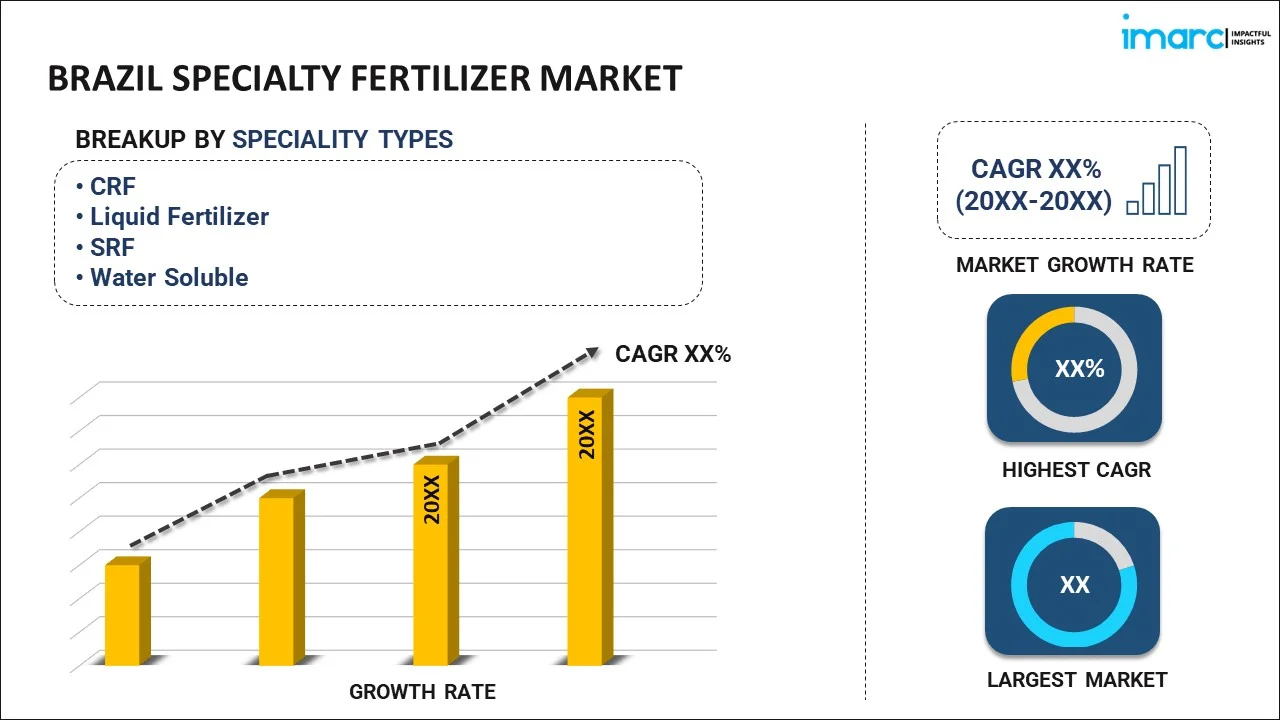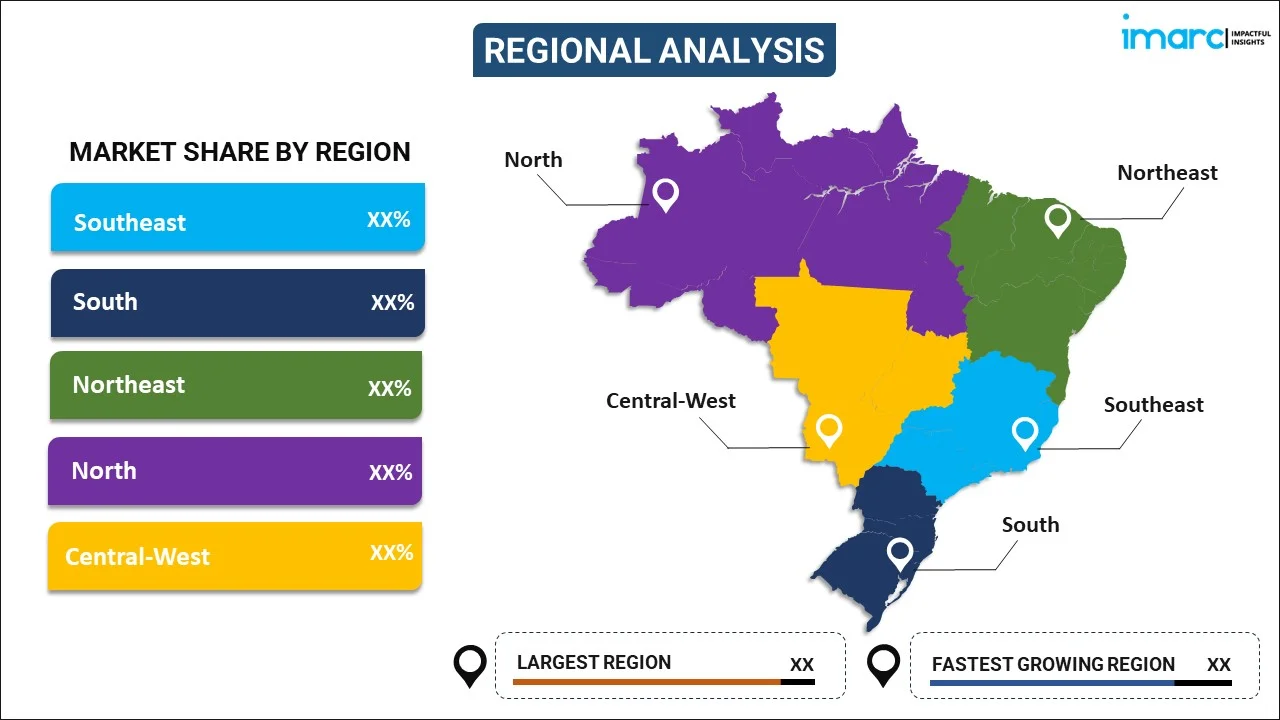
Brazil Specialty Fertilizer Market Report by Speciality Type (CRF, Liquid Fertilizer, SRF, Water Soluble), Application Mode (Fertigation, Foliar, Soil), Crop Type (Field Crops, Horticultural Crops, Turf and Ornamental), and Region 2025-2033
Market Overview:
Brazil specialty fertilizer market size reached USD 921 Million in 2024. Looking forward, IMARC Group expects the market to reach USD 1,755 Million by 2033, exhibiting a growth rate (CAGR) of 7.4% during 2025-2033. The rapid expansion of agricultural landscape, wide crop diversity across the region, growing environmental concerns, favorable government initiatives and policies, significant technological advancements, and ongoing research and development activities represent some of the key factors driving the market.
|
Report Attribute
|
Key Statistics
|
|---|---|
|
Base Year
|
2024
|
|
Forecast Years
|
2025-2033
|
|
Historical Years
|
2019-2024
|
|
Market Size in 2024
|
USD 921 Million |
|
Market Forecast in 2033
|
USD 1,755 Million |
| Market Growth Rate 2025-2033 | 7.4% |
Specialty fertilizers are specifically formulated to meet the unique nutritional needs of particular crops or to address specific soil deficiencies. Unlike standard fertilizers, which provide a broad spectrum of nutrients, specialty fertilizers are tailored to optimize the growth and yield of specific plants. These fertilizers can come in various forms, including granular, liquid, or slow-release, and they are designed to deliver essential nutrients such as nitrogen (N), phosphorus (P), and potassium (K), as well as micronutrients like iron, zinc, and magnesium, in precise proportions. The advantage of specialty fertilizers lies in their ability to enhance crop performance while minimizing environmental impact. By supplying plants with the nutrients, they require in the right amounts and at the right times, specialty fertilizers can improve nutrient use efficiency, reduce nutrient runoff, and mitigate soil nutrient imbalances. This targeted approach benefits crop yield and quality and also promotes sustainability in agriculture.
Brazil Specialty Fertilizer Market Trends:
Brazil is renowned for its vast agricultural landscape, with the country being one of the largest producers of various crops, including soybeans, sugarcane, and coffee globally. The continual expansion of agricultural activities in Brazil necessitates the use of specialty fertilizers to optimize crop yields and quality. Additionally, the diverse range of crops across Brazil, including tropical fruits, grains, and vegetables, requires specialized nutrient management. Specialty fertilizers offer tailored solutions to address the specific nutrient requirements of different crops, promoting better growth and enhanced yields. Other than this, the soils of Brazil exhibit significant variability in terms of pH, nutrient content, and texture. Specialty fertilizers can be customized to address these soil variations, ensuring that crops receive the precise nutrients they need for optimal growth. Besides this, Brazil is a major exporter of agricultural products, and the quality and quantity of these exports are vital for the economy of the country. Specialty fertilizers play a crucial role in ensuring the competitiveness of Brazilian agricultural products in international markets by improving crop quality and consistency. In line with this, the Brazilian government has implemented policies and incentives to promote sustainable agriculture and enhance food security. These policies often encourage the use of specialty fertilizers, as they can improve nutrient use efficiency and reduce the environmental footprint of agriculture. Furthermore, ongoing advancements in fertilizer technology have made it possible to create specialty fertilizers with innovative formulations. These products offer improved nutrient release mechanisms, extended nutrient availability, and better compatibility with modern farming practices.
Brazil Specialty Fertilizer Market Segmentation:
IMARC Group provides an analysis of the key trends in each segment of the market, along with forecasts at the country level for 2025-2033. Our report has categorized the market based on speciality type, application mode, and crop type.
Speciality Type Insights:

- CRF
- Polymer Coated
- Polymer-Sulfur Coated
- Others
- Liquid Fertilizer
- SRF
- Water Soluble
The report has provided a detailed breakup and analysis of the market based on the speciality type. This includes CRF (polymer coated, polymer-sulfur coated, and others), liquid fertilizer, SRF, and water soluble.
Application Mode Insights:
- Fertigation
- Foliar
- Soil
A detailed breakup and analysis of the market based on the application mode have also been provided in the report. This includes fertigation, foliar, and soil.
Crop Type Insights:
- Field Crops
- Horticultural Crops
- Turf and Ornamental
The report has provided a detailed breakup and analysis of the market based on the crop type. This includes field crops, horticultural crops, and turf and ornamental.
Regional Insights:

- Southeast
- South
- Northeast
- North
- Central-West
The report has also provided a comprehensive analysis of all the major regional markets, which include Southeast, South, Northeast, North, and Central-West.
Competitive Landscape:
The market research report has also provided a comprehensive analysis of the competitive landscape in the market. Competitive analysis such as market structure, key player positioning, top winning strategies, competitive dashboard, and company evaluation quadrant has been covered in the report. Also, detailed profiles of all major companies have been provided.
Brazil Specialty Fertilizer Market Report Coverage:
| Report Features | Details |
|---|---|
| Base Year of the Analysis | 2024 |
| Historical Period | 2019-2024 |
| Forecast Period | 2025-2033 |
| Units | Million USD |
| Scope of the Report | Exploration of Historical Trends and Market Outlook, Industry Catalysts and Challenges, Segment-Wise Historical and Future Market Assessment:
|
| Speciality Types Covered |
|
| Application Modes Covered | Fertigation, Foliar, Soil |
| Crop Types Covered | Field Crops, Horticultural Crops, Turf and Ornamental |
| Regions Covered | Southeast, South, Northeast, North, Central-West |
| Customization Scope | 10% Free Customization |
| Post-Sale Analyst Support | 9-11 Weeks |
| Delivery Format | PDF and Excel through Email (We can also provide the editable version of the report in PPT/Word format on special request) |
Key Questions Answered in This Report:
- How has the Brazil specialty fertilizer market performed so far and how will it perform in the coming years?
- What has been the impact of COVID-19 on the Brazil specialty fertilizer market?
- What is the breakup of the Brazil specialty fertilizer market on the basis of speciality type?
- What is the breakup of the Brazil specialty fertilizer market on the basis of application mode?
- What is the breakup of the Brazil specialty fertilizer market on the basis of crop type?
- What are the various stages in the value chain of the Brazil specialty fertilizer market?
- What are the key driving factors and challenges in the Brazil specialty fertilizer?
- What is the structure of the Brazil specialty fertilizer market and who are the key players?
- What is the degree of competition in the Brazil specialty fertilizer market?
Key Benefits for Stakeholders:
- IMARC’s industry report offers a comprehensive quantitative analysis of various market segments, historical and current market trends, market forecasts, and dynamics of the Brazil specialty fertilizer market from 2019-2033.
- The research report provides the latest information on the market drivers, challenges, and opportunities in the Brazil specialty fertilizer market.
- Porter's five forces analysis assist stakeholders in assessing the impact of new entrants, competitive rivalry, supplier power, buyer power, and the threat of substitution. It helps stakeholders to analyze the level of competition within the Brazil specialty fertilizer industry and its attractiveness.
- Competitive landscape allows stakeholders to understand their competitive environment and provides an insight into the current positions of key players in the market.
Need more help?
- Speak to our experienced analysts for insights on the current market scenarios.
- Include additional segments and countries to customize the report as per your requirement.
- Gain an unparalleled competitive advantage in your domain by understanding how to utilize the report and positively impacting your operations and revenue.
- For further assistance, please connect with our analysts.
 Inquire Before Buying
Inquire Before Buying
 Speak to an Analyst
Speak to an Analyst
 Request Brochure
Request Brochure
 Request Customization
Request Customization




.webp)




.webp)












